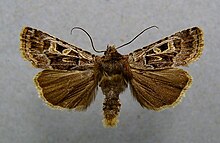You can help expand this article with text translated from the corresponding article in German. (October 2022) Click for important translation instructions.
|
| Chersotis ocellina | |
|---|---|

| |
| Scientific classification | |
| Domain: | Eukaryota |
| Kingdom: | Animalia |
| Phylum: | Arthropoda |
| Class: | Insecta |
| Order: | Lepidoptera |
| Superfamily: | Noctuoidea |
| Family: | Noctuidae |
| Genus: | Chersotis |
| Species: | C. ocellina |
| Binomial name | |
| Chersotis ocellina Denis & Schiffermüller, 1775 | |
| Synonyms | |
| |
Chersotis ocellina is a moth of the family Noctuidae. It is found in the mountainous areas of Europe, especially in the Alps (on heights between 1,500 and 2,500 meters), the Apennine Mountains, Pyrenees and the Cantabrian mountains.
Description
R. ocellina Schiff. (— phyteuma Esp.) (Ilk). The forewing is dark brown with more or less of a red tinge: the veins are pale to the outer line; the stigmata are pale, the upper with dark centres; the orbicular stigma is small and round or oval; the reniform is angled inwards along the median vein to touch the orbicular; the cell is black; the hind wings are brown. R. ocellina is a relatively small species (its wingspan is 25–28 mm.) occurring in the Mountains of Europe, Western Asia, and North and Central Asia. — The form transiens Stgr. [now species Chersotis transiens Staudinger, 1896), which is found in Central Asia only, is paler and approaches Chersotis alpestris. The larvae are brown; the dorsal line is pale; the lateral lines are pale and inwardly brown-bordered, and the whole dorsal field between them is darker; the spiracles are brown, each with two pale-ringed black tubercles above them; the head and anal plate are brown; the thoracic plate is black with three yellow streaks; the larvae live on various low plants.
Biology
The moth flies from July to August in one generation.
The larvae feed on various herbaceous plants.
Subspecies
There are two recognised subspecies:
- Chersotis ocellina ocellina
- Chersotis ocellina pyrenaellina (Pyrenees)
References
- Warren, W. in Seitz, A. Ed., 1914 Die Großschmetterlinge der Erde, Verlag Alfred Kernen, Stuttgart Band 3: Abt. 1, Die Großschmetterlinge des palaearktischen Faunengebietes, Die palaearktischen eulenartigen Nachtfalter, 1914
 This article incorporates text from this source, which is in the public domain.
This article incorporates text from this source, which is in the public domain.
- L. Rezbanyai-Reser: Chersotis-Studien 2. Chersotis ocellina pyrenaellina ssp.n. aus den Pyrenaen (Lepidoptera: Noctuidae). Entomologische Berichte Luzern, 41: 95-102, Luzern 1999
External links
- www.lepiforum.de
- www.nic.funet.fi
- www.schmetterlinge-deutschlands.de Archived 2011-10-05 at the Wayback Machine
- Fauna Europaea
| Taxon identifiers | |
|---|---|
| Chersotis ocellina |
|
This Noctuinae-related article is a stub. You can help Misplaced Pages by expanding it. |